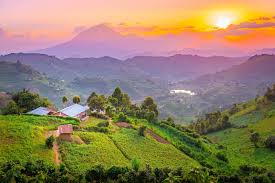
Uganda’s climate
Uganda’s climate is indeed beautiful and diverse, contributing to its lush landscapes and vibrant ecosystems. The country’s tropical climate is balanced by its altitude, which means that even though Uganda lies near the equator, its temperatures remain quite moderate in many areas. The climate has a few key features:
1. Tropical Warmth with Cool Highlands
- Lowland Areas (e.g., Kampala, Jinja, Entebbe): These regions are warm year-round, with temperatures typically ranging from 21°C to 30°C (70°F to 86°F). The proximity to Lake Victoria also brings moderate humidity, but it’s generally not oppressive.
- Highland Regions (e.g., Fort Portal, Kabale, Rwenzori Mountains): At higher altitudes, the weather cools down significantly. Areas like Kabale are cooler, with temperatures around 14°C to 24°C (57°F to 75°F). The Rwenzori Mountains, known as the “Mountains of the Moon,” can get quite cold, especially at night, with temperatures dropping to near freezing in the higher elevations.
2. Two Rainy Seasons
- The Long Rains (March to May): The most significant rainy season, when much of the country gets heavy rainfall. The lush landscapes thrive during this period, turning the country a vibrant green.
- The Short Rains (September to November): A secondary rainy season, though less intense, it still brings refreshing showers.
- Dry Seasons: The dry months (June to August and December to February) are a perfect time for travel, as the temperatures remain warm but comfortable, and the rains subside.
3. Moderate Humidity
- Although Uganda is in the tropics, the humidity isn’t too intense thanks to its highlands and the moderating effect of the great lakes. Places near Lake Victoria, like Entebbe, have relatively mild humidity levels that make the atmosphere comfortable, especially in the evenings when temperatures drop.
4. Microclimates
- Uganda’s diverse topography creates microclimates. For example, the dry savanna climate of the north (places like Gulu) contrasts with the more temperate, rainy highlands in the southwest. This means that Uganda can offer a variety of experiences based on where you visit.
5. Great for Outdoor Activities
- The overall pleasant climate makes Uganda an ideal place for outdoor activities. Whether you’re trekking in the Rwenzori Mountains, going on a safari in Murchison Falls or Queen Elizabeth National Park, or visiting the Bwindi Impenetrable Forest for gorilla trekking, the weather supports year-round adventure.
Uganda’s climate truly adds to its charm, especially when you consider the rich biodiversity, ranging from tropical rainforests to savannah and wetlands.
Have you experienced the weather in Uganda firsthand, or is it something you’re looking forward to exploring?
Tags:#climate
Recent Posts
All Categories
Tags
#bodabodas
#climate
#crestedcrane
#fearofflying
#gorillas
#kibalenationalpark
#lakemburonationalpark
#motorcycle
#mountainElgon
#mountains
#murchisonfallsnationalpark
#murchsionfallsnationalpark
#nationalparks
#rhinos
#Rolex
#Rwenzori moutains
#semulikinationalpark
#tourism
#tourUganda
#Uganda
#visistUganda
#visitUganda

Wildlife
Thailand





